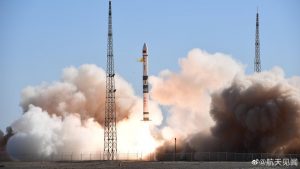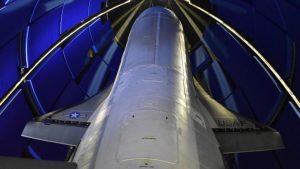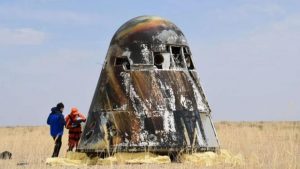Media
Transcript
A Kuaye-joe Kuaizhou 1A rocket launched two Xingyun-2 satellites from Jiǔquán Satellite Launch Center on May 12, 2020 at 1:16 AM (UTC).
This was the 9th Kuaye-joe Kuaizhou 1A flight, launched from a transporter erector launcher, or TEL. To give a better idea of the rocket’s size, it’s smaller than Falcon 1 but bigger than Electron.

The rocket utilized 3 solid stages and 1 liquid stage of fuel; the solid fuel type is still unknown, but the liquid fuel is most likely the pretty but deadly nitrogen tetroxide and unsymmetrical dimethylhydrazine.
CASIC dedicated this particular launch to health care workers in Wuhan — where the rockets are manufactured and where the novel coronavirus appeared — for their tireless efforts.
Gathering information about this rocket was a linguistic adventure for our team, who rely on less than perfect machine-translated Chinese. Fun fact: the Chinese words for rocket and satellite translate as “arrow” and “star”.
The Kuaye-joe Kuaizhou 1A’s payload was a pair of Xingyun-2 satellites built by sing-you Xingyun Satellite Co.
These low-earth orbit satellites weigh 93 kilograms — that’s about 47 two-liter soda bottles — and are prototypes for a future 80-satellite constellation for Internet of Things, such as: communicating with sensors for polar and marine environmental monitoring, “geological disaster” monitoring, weather data collection for forecasting, and communication with cargo vessels for shipping and container tracking.
They will test long-distance satellite-to-satellite communications independent of ground stations, meaning satellites can directly communicate with each other. While this technology already exists, it is the first time China has built such a system.

At 9:14am Eastern (13:14 UTC) on Sunday, May 17th, the US Air Force’s reusable Orbital Test Vehicle, more commonly known as the X-37B space plane, was launched into orbit on top of a United Launch Alliance Atlas 5 rocket from SLC 41 at Cape Canaveral, marking the start of the sixth flight since 2010.
The U.S. military and ULA dedicated the launch to coronavirus first responders, front-line workers, and victims of the disease.
Amateur satellite trackers have calculated that the orbit appears to be about 200 miles (~350 km) in altitude at an inclination of about 44 degrees.
As you can imagine, there’s not too much information available about the OTV-6 mission. But, it is known that besides the classified military objectives, the space plane was upgraded to support additional scientific experiments, and FalconSAT-8, a 136 kg technology demonstration satellite roughly the size of a washing machine.
Two of the experiments are being flown for NASA. One is studying the effect of ambient space radiation on seeds, while the other is a sample plate evaluating how various materials react to the conditions of space.
One of the military experiments that belongs to the Naval Research Laboratory will be converting solar power into microwave energy that will be transmitted to Earth.
The X-37B is a reusable space vehicle designed to deploy small satellites, host experiments and “pursue other classified objectives”. It generates electricity using solar panels and can glide to land on a runway at the end of a mission autonomously. The Air Force owns two of the vehicles, both of which were built by Boeing.
The previous five OTV missions add up to just under 8 years in orbit, with the last mission having a duration of 780 days.
The first test of the Chinese next-generation crewed spacecraft returned to Earth and finished its mission on May 8th, after spending two days and nineteen hours in orbit.

The primary mission of this launch was to test several aspects of the new spacecraft. China National Space Agency announced that the unnamed craft has passed all checks for its autonomous flight control and landing system, a new engine with non-toxic fuel, a Chinese-made ceramic heat-proof coating, the parachute and the airbag deployment.
Photos of craft show a scorched exterior with several missing panels. In an interview with China Youth Daily, chief designer Wang Ping explained that the appearance is nominal. The missing panels were designed to separate from the craft to reveal the parachute and airbag mechanisms. The discoloration is from the protective white outer coating vaporizing off due to the heat and friction encountered during reentry.
The biggest differences between this craft and current Chinese spacecraft is the size and how far it can travel. The current Chinese craft is only capable of carrying three-person crews to low Earth orbit for space stations and don’t have the capabilities needed for lunar missions. The new craft is larger and will be able to carry up to seven taikonauts for a space station mission. With a bit of rearrangement of the cabin, up to 500 kilograms of cargo and be transported with three taikonauts on either space station or lunar missions.
To wrap things up, here’s a running tally of a few spaceflight statistics for the current year:
Toilets burned up: 2
Total new satellites in orbit: 408 (includes those launched from other in-orbit craft, such as the ISS)
Total satellites from launches: 392
Total 2020 launch attempts: 33 (including 4 failures)
I keep track of orbital launches by where they launched from. Here’s that breakdown:
USA: 11
China: 10
Kazakhstan: 4
French Guiana: 2
Russia: 2
Iran: 2
New Zealand: 1
Japan: 1
Your useless space fact for the week is that “Venus comprises 41% by mass of the inner Solar System compared to 50% for Earth and only 5% for Mars.” That’s literally a quote from the paper What is the Oxygen Isotope Composition of Venus? The Scientific Case for Sample Return from Earth’s “Sister” Planet authored by Richard C Greenwood and Mahesh Anand published earlier this month in Space Science Reviews
And that rounds out our show for today.
Learn More
Kuaizhou Rocket and Xingyun Satellite “Combine” for the First Time
- CASIC press release (Chinese)
- CNSA press release (Chinese)
- Xinhua article (Chinese)
Upgraded X-37B spaceplane rockets into orbit aboard Atlas 5 launcher
China’s new generation of crewed spaceship test ship successfully returned
- CNSA press release (Chinese)
- Spaceflight Fans article (Chinese)
- China Youth Daily online article from the spacecraft’s perspective (Chinese)
Credits
Host: Annie Wilson
Writers: Annie Wilson, Dave Ballard, Gordon Dewis
Audio and Video Editing: Ally Pelphrey
Content Editing: Beth Johnson
Executive Producer: Pamela Gay
Intro and Outro music by Kevin MacLeod, https://incompetech.com/music/


 We record most shows live, on Twitch. Follow us today to get alerts when we go live.
We record most shows live, on Twitch. Follow us today to get alerts when we go live.